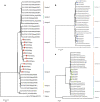Etiology and clinical characteristics of SARS-CoV-2 and other human coronaviruses among children in Zhejiang Province, China 2017-2019
- PMID: 33931105
- PMCID: PMC8085659
- DOI: 10.1186/s12985-021-01562-8
Etiology and clinical characteristics of SARS-CoV-2 and other human coronaviruses among children in Zhejiang Province, China 2017-2019
Abstract
Background: A novel coronavirus (SARS-CoV-2) emerging has put global public health institutes on high alert. Little is known about the epidemiology and clinical characteristics of human coronaviruses infections in relation to infections with other respiratory viruses.
Methods: From February 2017 to December 2019, 3660 respiratory samples submitted to Zhejiang Children Hospital with acute respiratory symptoms were tested for four human coronaviruses RNA by a novel two-tube multiplex reverse transcription polymerase chain reaction assays. Samples were also screened for the occurrence of SARS-CoV-2 by reverse transcription-PCR analysis.
Results: Coronavirus RNAs were detected in 144 (3.93%) specimens: HCoV-HKU1 in 38 specimens, HCoV-NL63 in 62 specimens, HCoV-OC43 in 38 specimens and HCoV-229E in 8 specimens. Genomes for SARS-CoV-2 were absent in all specimens by RT-PCR analysis during the study period. The majority of HCoV infections occurred during fall months. No significant differences in gender, sample type, year were seen across species. 37.5 to 52.6% of coronaviruses detected were in specimens testing positive for other respiratory viruses. Phylogenic analysis identified that Zhejiang coronaviruses belong to multiple lineages of the coronaviruses circulating in other countries and areas.
Conclusion: Common HCoVs may have annual peaks of circulation in fall months in the Zhejiang province, China. Genetic relatedness to the coronaviruses in other regions suggests further surveillance on human coronaviruses in clinical samples are clearly needed to understand their patterns of activity and role in the emergence of novel coronaviruses.
Keywords: Acute respiratory infection; Hospitalized children; Human coronavirus; Phylogenic analysis; SARS-CoV-2.
Conflict of interest statement
The authors declare that they have no competing interests.
Figures





References
Publication types
MeSH terms
Substances
Grants and funding
LinkOut - more resources
Full Text Sources
Other Literature Sources
Medical
Miscellaneous

